Non Medical Prescribing: Case Study Reflection Template
VerifiedAdded on 2022/11/28
|12
|2706
|227
AI Summary
This document is a case study reflection template for non medical prescribing. It includes a prescribing framework, patient information, clinical findings, past medical history, prescribed medication history, and more.
Contribute Materials
Your contribution can guide someone’s learning journey. Share your
documents today.
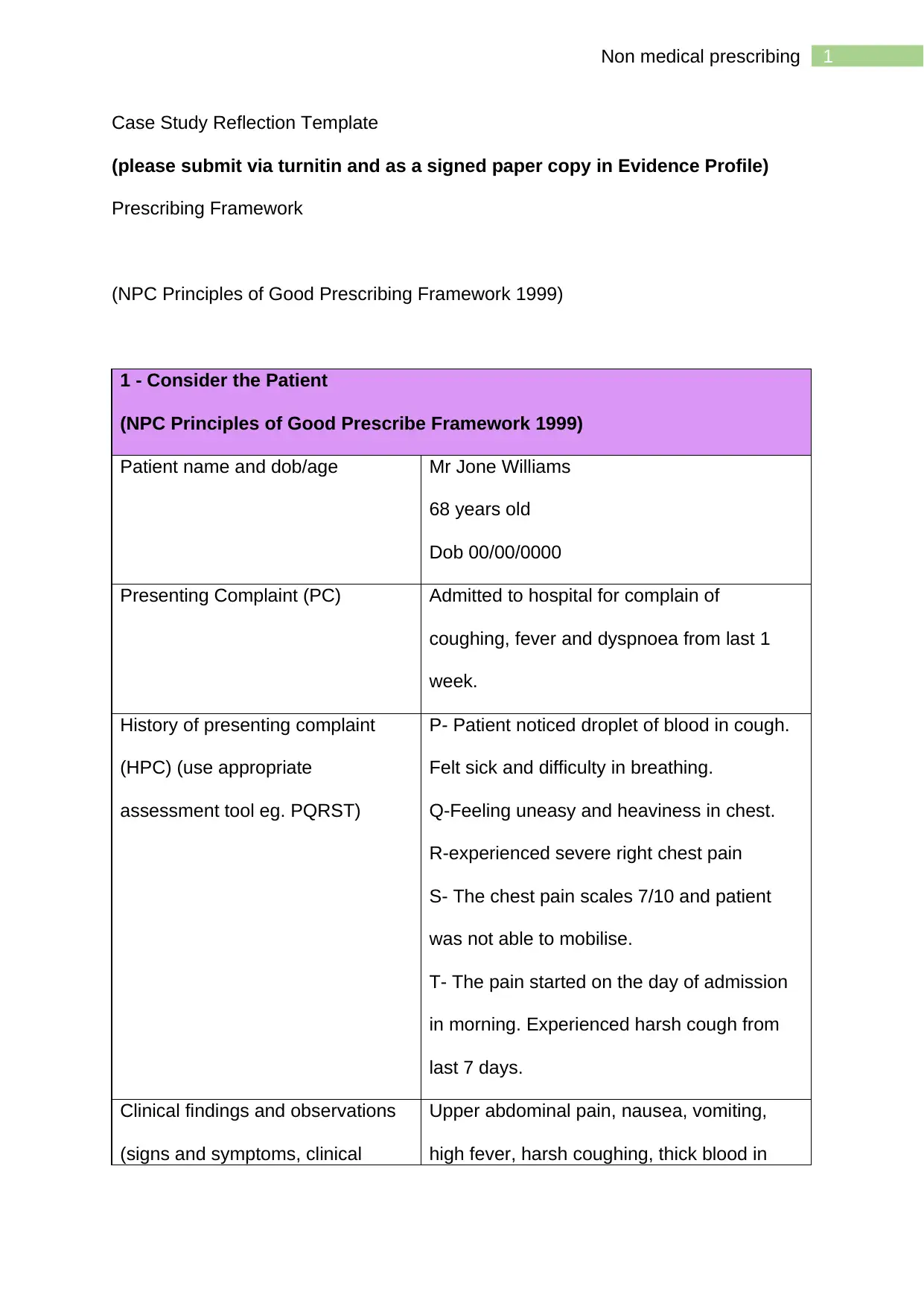
1Non medical prescribing
Case Study Reflection Template
(please submit via turnitin and as a signed paper copy in Evidence Profile)
Prescribing Framework
(NPC Principles of Good Prescribing Framework 1999)
1 - Consider the Patient
(NPC Principles of Good Prescribe Framework 1999)
Patient name and dob/age Mr Jone Williams
68 years old
Dob 00/00/0000
Presenting Complaint (PC) Admitted to hospital for complain of
coughing, fever and dyspnoea from last 1
week.
History of presenting complaint
(HPC) (use appropriate
assessment tool eg. PQRST)
P- Patient noticed droplet of blood in cough.
Felt sick and difficulty in breathing.
Q-Feeling uneasy and heaviness in chest.
R-experienced severe right chest pain
S- The chest pain scales 7/10 and patient
was not able to mobilise.
T- The pain started on the day of admission
in morning. Experienced harsh cough from
last 7 days.
Clinical findings and observations
(signs and symptoms, clinical
Upper abdominal pain, nausea, vomiting,
high fever, harsh coughing, thick blood in
Case Study Reflection Template
(please submit via turnitin and as a signed paper copy in Evidence Profile)
Prescribing Framework
(NPC Principles of Good Prescribing Framework 1999)
1 - Consider the Patient
(NPC Principles of Good Prescribe Framework 1999)
Patient name and dob/age Mr Jone Williams
68 years old
Dob 00/00/0000
Presenting Complaint (PC) Admitted to hospital for complain of
coughing, fever and dyspnoea from last 1
week.
History of presenting complaint
(HPC) (use appropriate
assessment tool eg. PQRST)
P- Patient noticed droplet of blood in cough.
Felt sick and difficulty in breathing.
Q-Feeling uneasy and heaviness in chest.
R-experienced severe right chest pain
S- The chest pain scales 7/10 and patient
was not able to mobilise.
T- The pain started on the day of admission
in morning. Experienced harsh cough from
last 7 days.
Clinical findings and observations
(signs and symptoms, clinical
Upper abdominal pain, nausea, vomiting,
high fever, harsh coughing, thick blood in
Secure Best Marks with AI Grader
Need help grading? Try our AI Grader for instant feedback on your assignments.
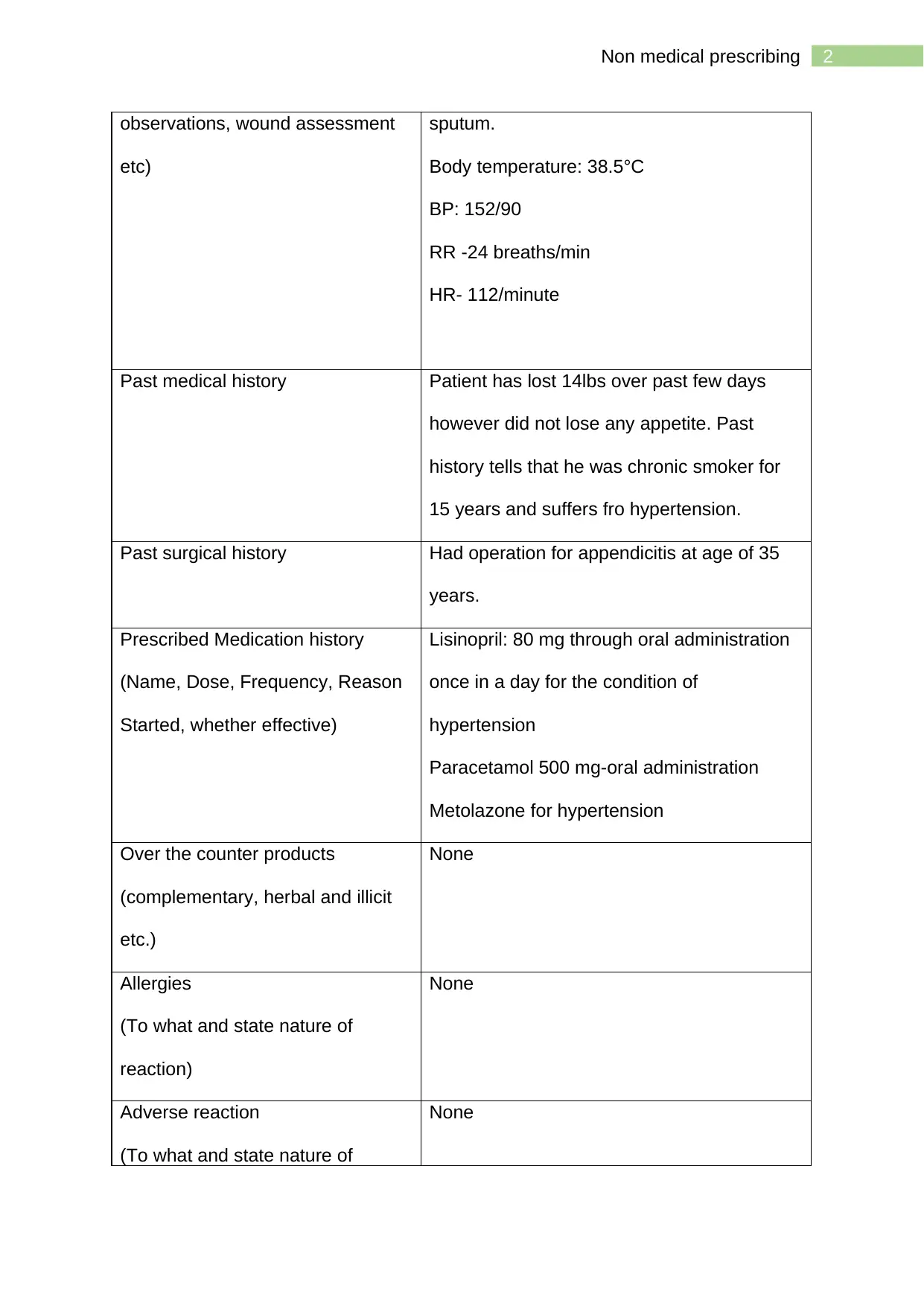
2Non medical prescribing
observations, wound assessment
etc)
sputum.
Body temperature: 38.5°C
BP: 152/90
RR -24 breaths/min
HR- 112/minute
Past medical history Patient has lost 14lbs over past few days
however did not lose any appetite. Past
history tells that he was chronic smoker for
15 years and suffers fro hypertension.
Past surgical history Had operation for appendicitis at age of 35
years.
Prescribed Medication history
(Name, Dose, Frequency, Reason
Started, whether effective)
Lisinopril: 80 mg through oral administration
once in a day for the condition of
hypertension
Paracetamol 500 mg-oral administration
Metolazone for hypertension
Over the counter products
(complementary, herbal and illicit
etc.)
None
Allergies
(To what and state nature of
reaction)
None
Adverse reaction
(To what and state nature of
None
observations, wound assessment
etc)
sputum.
Body temperature: 38.5°C
BP: 152/90
RR -24 breaths/min
HR- 112/minute
Past medical history Patient has lost 14lbs over past few days
however did not lose any appetite. Past
history tells that he was chronic smoker for
15 years and suffers fro hypertension.
Past surgical history Had operation for appendicitis at age of 35
years.
Prescribed Medication history
(Name, Dose, Frequency, Reason
Started, whether effective)
Lisinopril: 80 mg through oral administration
once in a day for the condition of
hypertension
Paracetamol 500 mg-oral administration
Metolazone for hypertension
Over the counter products
(complementary, herbal and illicit
etc.)
None
Allergies
(To what and state nature of
reaction)
None
Adverse reaction
(To what and state nature of
None
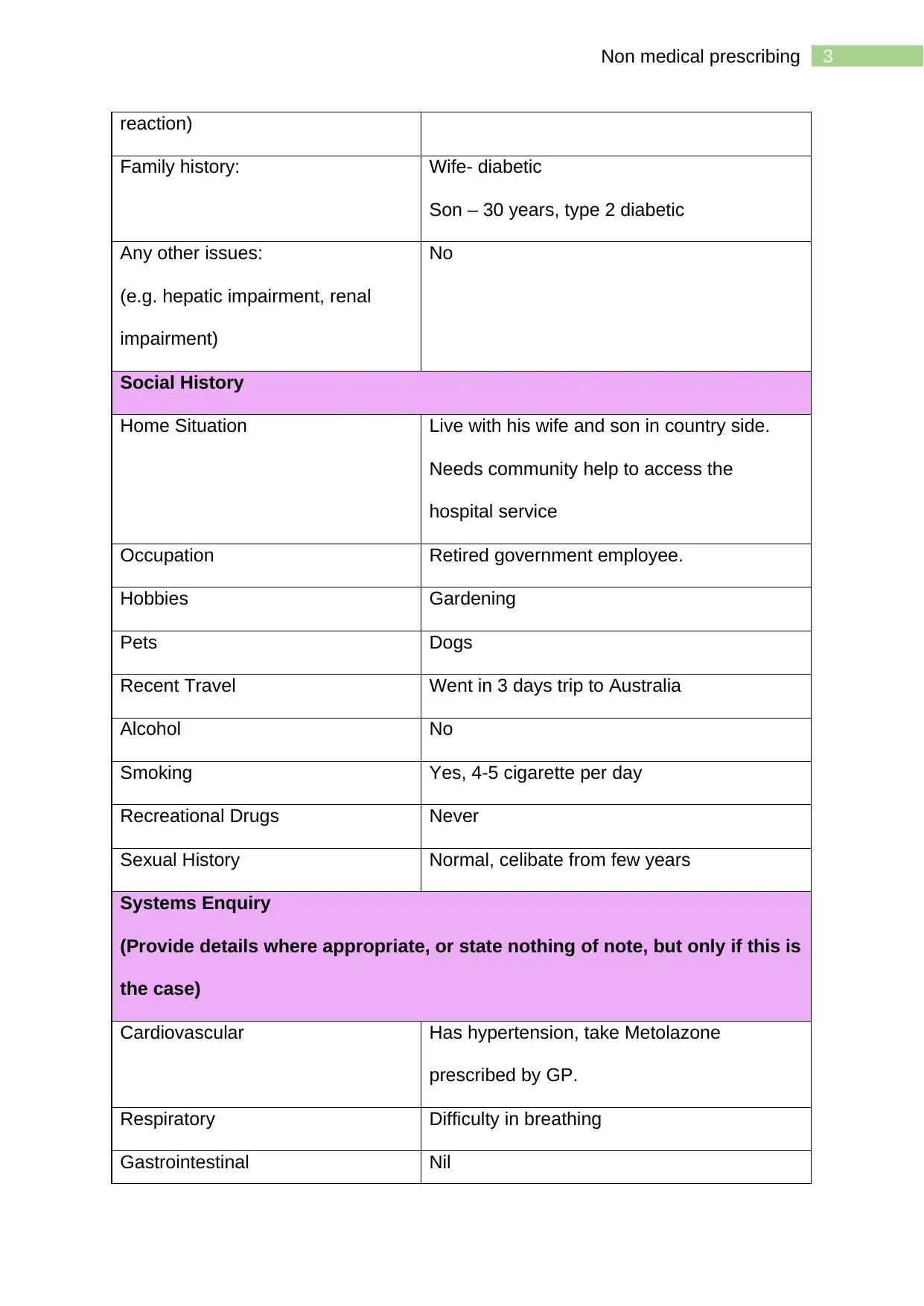
3Non medical prescribing
reaction)
Family history: Wife- diabetic
Son – 30 years, type 2 diabetic
Any other issues:
(e.g. hepatic impairment, renal
impairment)
No
Social History
Home Situation Live with his wife and son in country side.
Needs community help to access the
hospital service
Occupation Retired government employee.
Hobbies Gardening
Pets Dogs
Recent Travel Went in 3 days trip to Australia
Alcohol No
Smoking Yes, 4-5 cigarette per day
Recreational Drugs Never
Sexual History Normal, celibate from few years
Systems Enquiry
(Provide details where appropriate, or state nothing of note, but only if this is
the case)
Cardiovascular Has hypertension, take Metolazone
prescribed by GP.
Respiratory Difficulty in breathing
Gastrointestinal Nil
reaction)
Family history: Wife- diabetic
Son – 30 years, type 2 diabetic
Any other issues:
(e.g. hepatic impairment, renal
impairment)
No
Social History
Home Situation Live with his wife and son in country side.
Needs community help to access the
hospital service
Occupation Retired government employee.
Hobbies Gardening
Pets Dogs
Recent Travel Went in 3 days trip to Australia
Alcohol No
Smoking Yes, 4-5 cigarette per day
Recreational Drugs Never
Sexual History Normal, celibate from few years
Systems Enquiry
(Provide details where appropriate, or state nothing of note, but only if this is
the case)
Cardiovascular Has hypertension, take Metolazone
prescribed by GP.
Respiratory Difficulty in breathing
Gastrointestinal Nil
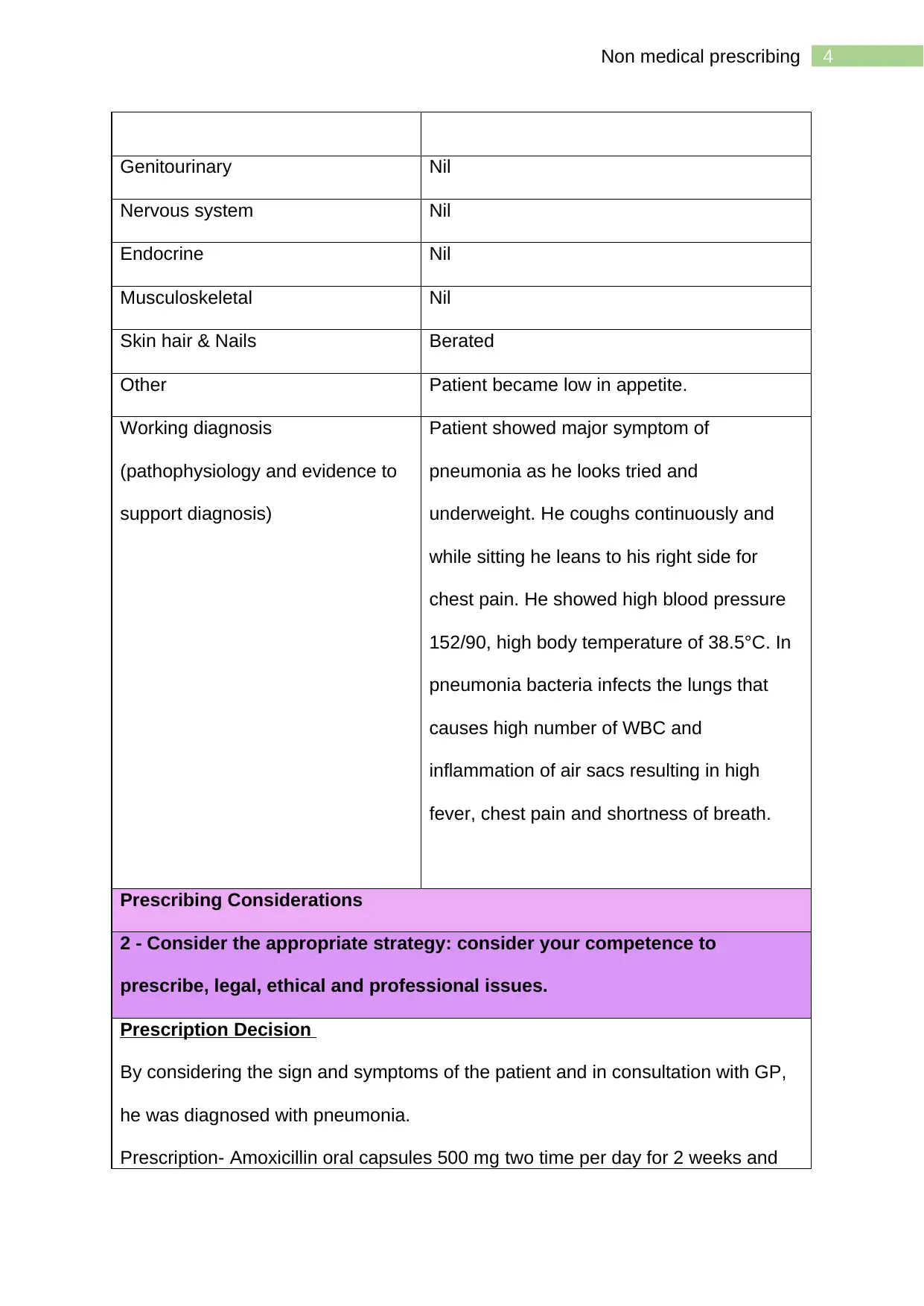
4Non medical prescribing
Genitourinary Nil
Nervous system Nil
Endocrine Nil
Musculoskeletal Nil
Skin hair & Nails Berated
Other Patient became low in appetite.
Working diagnosis
(pathophysiology and evidence to
support diagnosis)
Patient showed major symptom of
pneumonia as he looks tried and
underweight. He coughs continuously and
while sitting he leans to his right side for
chest pain. He showed high blood pressure
152/90, high body temperature of 38.5°C. In
pneumonia bacteria infects the lungs that
causes high number of WBC and
inflammation of air sacs resulting in high
fever, chest pain and shortness of breath.
Prescribing Considerations
2 - Consider the appropriate strategy: consider your competence to
prescribe, legal, ethical and professional issues.
Prescription Decision
By considering the sign and symptoms of the patient and in consultation with GP,
he was diagnosed with pneumonia.
Prescription- Amoxicillin oral capsules 500 mg two time per day for 2 weeks and
Genitourinary Nil
Nervous system Nil
Endocrine Nil
Musculoskeletal Nil
Skin hair & Nails Berated
Other Patient became low in appetite.
Working diagnosis
(pathophysiology and evidence to
support diagnosis)
Patient showed major symptom of
pneumonia as he looks tried and
underweight. He coughs continuously and
while sitting he leans to his right side for
chest pain. He showed high blood pressure
152/90, high body temperature of 38.5°C. In
pneumonia bacteria infects the lungs that
causes high number of WBC and
inflammation of air sacs resulting in high
fever, chest pain and shortness of breath.
Prescribing Considerations
2 - Consider the appropriate strategy: consider your competence to
prescribe, legal, ethical and professional issues.
Prescription Decision
By considering the sign and symptoms of the patient and in consultation with GP,
he was diagnosed with pneumonia.
Prescription- Amoxicillin oral capsules 500 mg two time per day for 2 weeks and
Secure Best Marks with AI Grader
Need help grading? Try our AI Grader for instant feedback on your assignments.
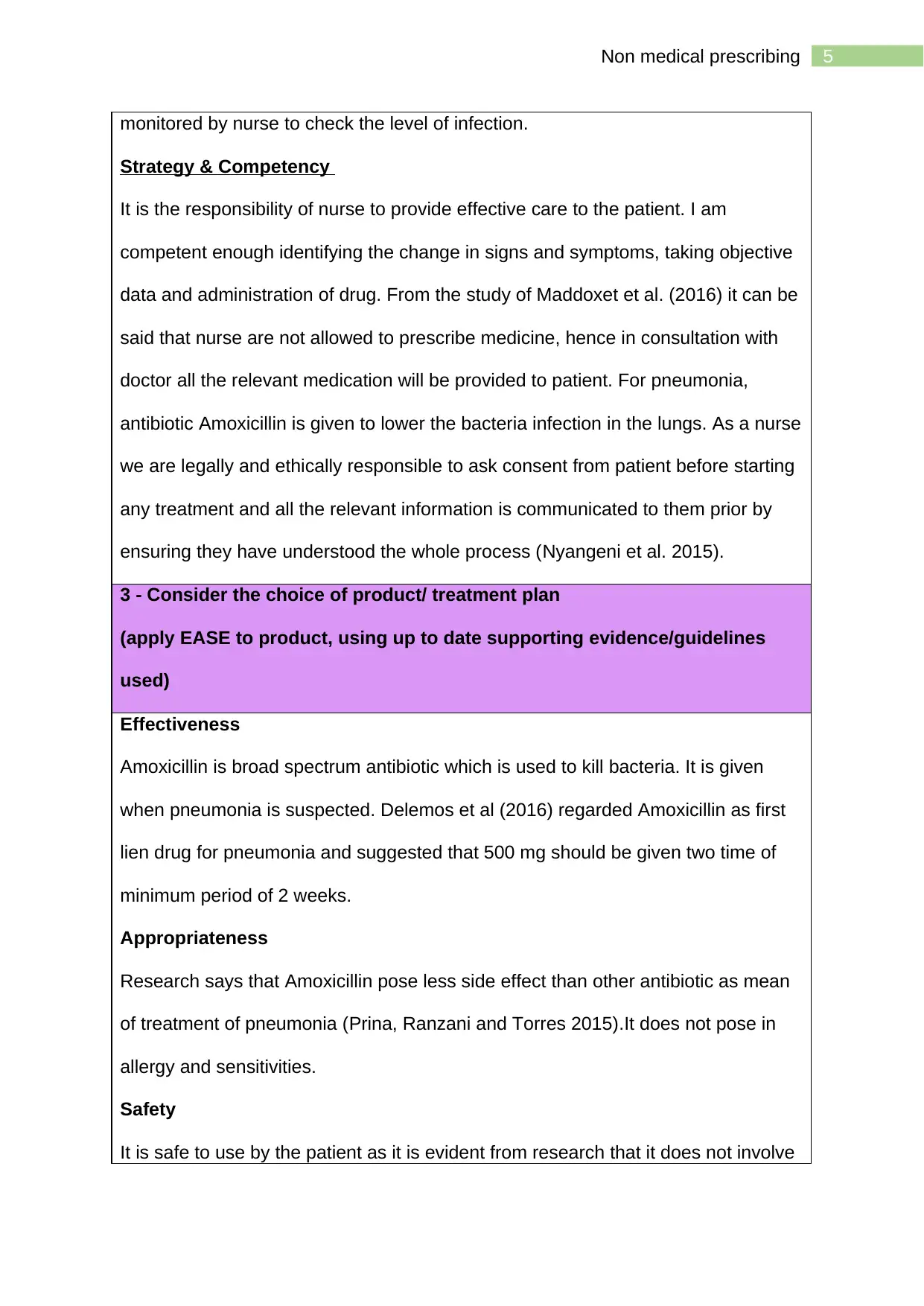
5Non medical prescribing
monitored by nurse to check the level of infection.
Strategy & Competency
It is the responsibility of nurse to provide effective care to the patient. I am
competent enough identifying the change in signs and symptoms, taking objective
data and administration of drug. From the study of Maddoxet et al. (2016) it can be
said that nurse are not allowed to prescribe medicine, hence in consultation with
doctor all the relevant medication will be provided to patient. For pneumonia,
antibiotic Amoxicillin is given to lower the bacteria infection in the lungs. As a nurse
we are legally and ethically responsible to ask consent from patient before starting
any treatment and all the relevant information is communicated to them prior by
ensuring they have understood the whole process (Nyangeni et al. 2015).
3 - Consider the choice of product/ treatment plan
(apply EASE to product, using up to date supporting evidence/guidelines
used)
Effectiveness
Amoxicillin is broad spectrum antibiotic which is used to kill bacteria. It is given
when pneumonia is suspected. Delemos et al (2016) regarded Amoxicillin as first
lien drug for pneumonia and suggested that 500 mg should be given two time of
minimum period of 2 weeks.
Appropriateness
Research says that Amoxicillin pose less side effect than other antibiotic as mean
of treatment of pneumonia (Prina, Ranzani and Torres 2015).It does not pose in
allergy and sensitivities.
Safety
It is safe to use by the patient as it is evident from research that it does not involve
monitored by nurse to check the level of infection.
Strategy & Competency
It is the responsibility of nurse to provide effective care to the patient. I am
competent enough identifying the change in signs and symptoms, taking objective
data and administration of drug. From the study of Maddoxet et al. (2016) it can be
said that nurse are not allowed to prescribe medicine, hence in consultation with
doctor all the relevant medication will be provided to patient. For pneumonia,
antibiotic Amoxicillin is given to lower the bacteria infection in the lungs. As a nurse
we are legally and ethically responsible to ask consent from patient before starting
any treatment and all the relevant information is communicated to them prior by
ensuring they have understood the whole process (Nyangeni et al. 2015).
3 - Consider the choice of product/ treatment plan
(apply EASE to product, using up to date supporting evidence/guidelines
used)
Effectiveness
Amoxicillin is broad spectrum antibiotic which is used to kill bacteria. It is given
when pneumonia is suspected. Delemos et al (2016) regarded Amoxicillin as first
lien drug for pneumonia and suggested that 500 mg should be given two time of
minimum period of 2 weeks.
Appropriateness
Research says that Amoxicillin pose less side effect than other antibiotic as mean
of treatment of pneumonia (Prina, Ranzani and Torres 2015).It does not pose in
allergy and sensitivities.
Safety
It is safe to use by the patient as it is evident from research that it does not involve
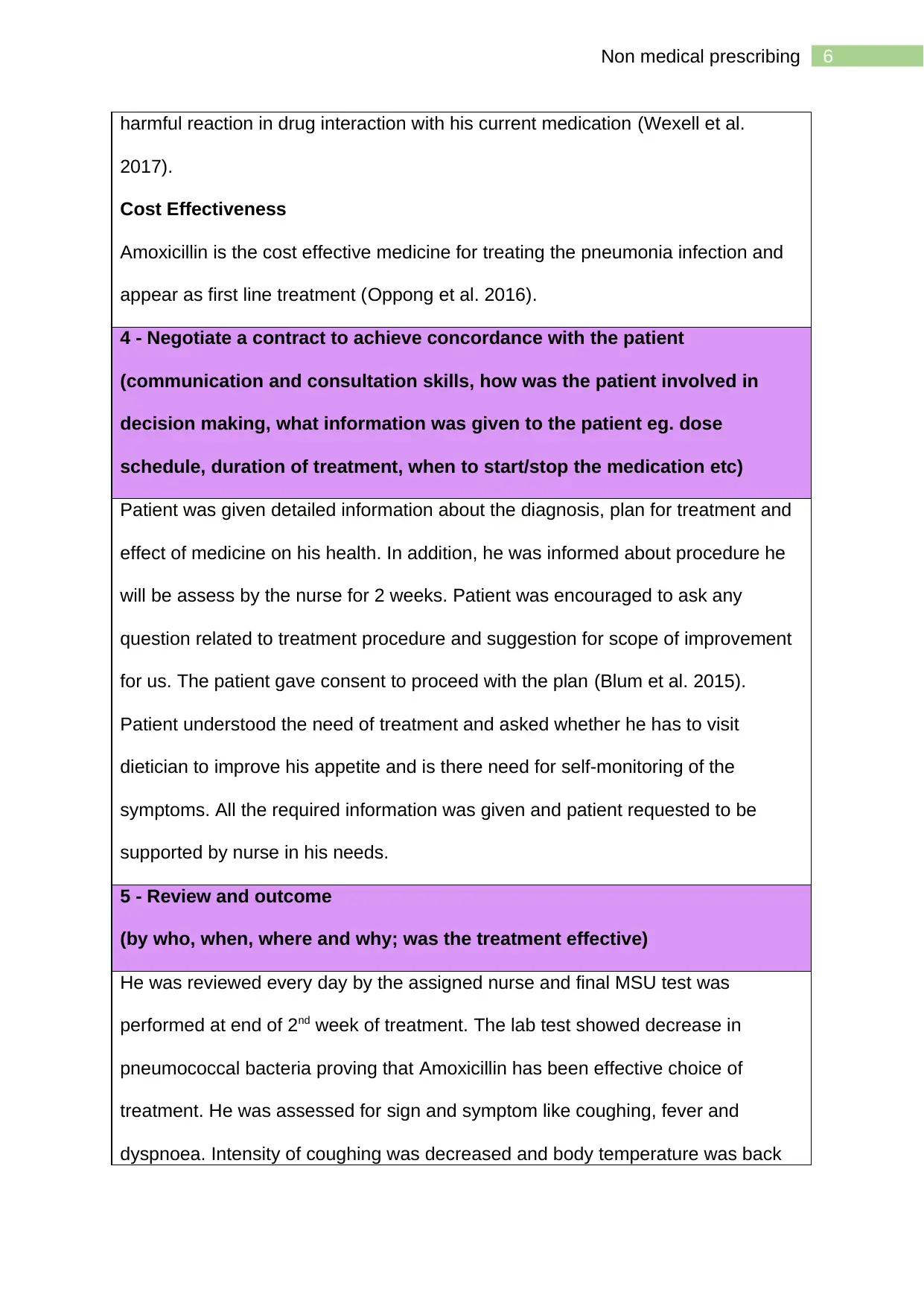
6Non medical prescribing
harmful reaction in drug interaction with his current medication (Wexell et al.
2017).
Cost Effectiveness
Amoxicillin is the cost effective medicine for treating the pneumonia infection and
appear as first line treatment (Oppong et al. 2016).
4 - Negotiate a contract to achieve concordance with the patient
(communication and consultation skills, how was the patient involved in
decision making, what information was given to the patient eg. dose
schedule, duration of treatment, when to start/stop the medication etc)
Patient was given detailed information about the diagnosis, plan for treatment and
effect of medicine on his health. In addition, he was informed about procedure he
will be assess by the nurse for 2 weeks. Patient was encouraged to ask any
question related to treatment procedure and suggestion for scope of improvement
for us. The patient gave consent to proceed with the plan (Blum et al. 2015).
Patient understood the need of treatment and asked whether he has to visit
dietician to improve his appetite and is there need for self-monitoring of the
symptoms. All the required information was given and patient requested to be
supported by nurse in his needs.
5 - Review and outcome
(by who, when, where and why; was the treatment effective)
He was reviewed every day by the assigned nurse and final MSU test was
performed at end of 2nd week of treatment. The lab test showed decrease in
pneumococcal bacteria proving that Amoxicillin has been effective choice of
treatment. He was assessed for sign and symptom like coughing, fever and
dyspnoea. Intensity of coughing was decreased and body temperature was back
harmful reaction in drug interaction with his current medication (Wexell et al.
2017).
Cost Effectiveness
Amoxicillin is the cost effective medicine for treating the pneumonia infection and
appear as first line treatment (Oppong et al. 2016).
4 - Negotiate a contract to achieve concordance with the patient
(communication and consultation skills, how was the patient involved in
decision making, what information was given to the patient eg. dose
schedule, duration of treatment, when to start/stop the medication etc)
Patient was given detailed information about the diagnosis, plan for treatment and
effect of medicine on his health. In addition, he was informed about procedure he
will be assess by the nurse for 2 weeks. Patient was encouraged to ask any
question related to treatment procedure and suggestion for scope of improvement
for us. The patient gave consent to proceed with the plan (Blum et al. 2015).
Patient understood the need of treatment and asked whether he has to visit
dietician to improve his appetite and is there need for self-monitoring of the
symptoms. All the required information was given and patient requested to be
supported by nurse in his needs.
5 - Review and outcome
(by who, when, where and why; was the treatment effective)
He was reviewed every day by the assigned nurse and final MSU test was
performed at end of 2nd week of treatment. The lab test showed decrease in
pneumococcal bacteria proving that Amoxicillin has been effective choice of
treatment. He was assessed for sign and symptom like coughing, fever and
dyspnoea. Intensity of coughing was decreased and body temperature was back
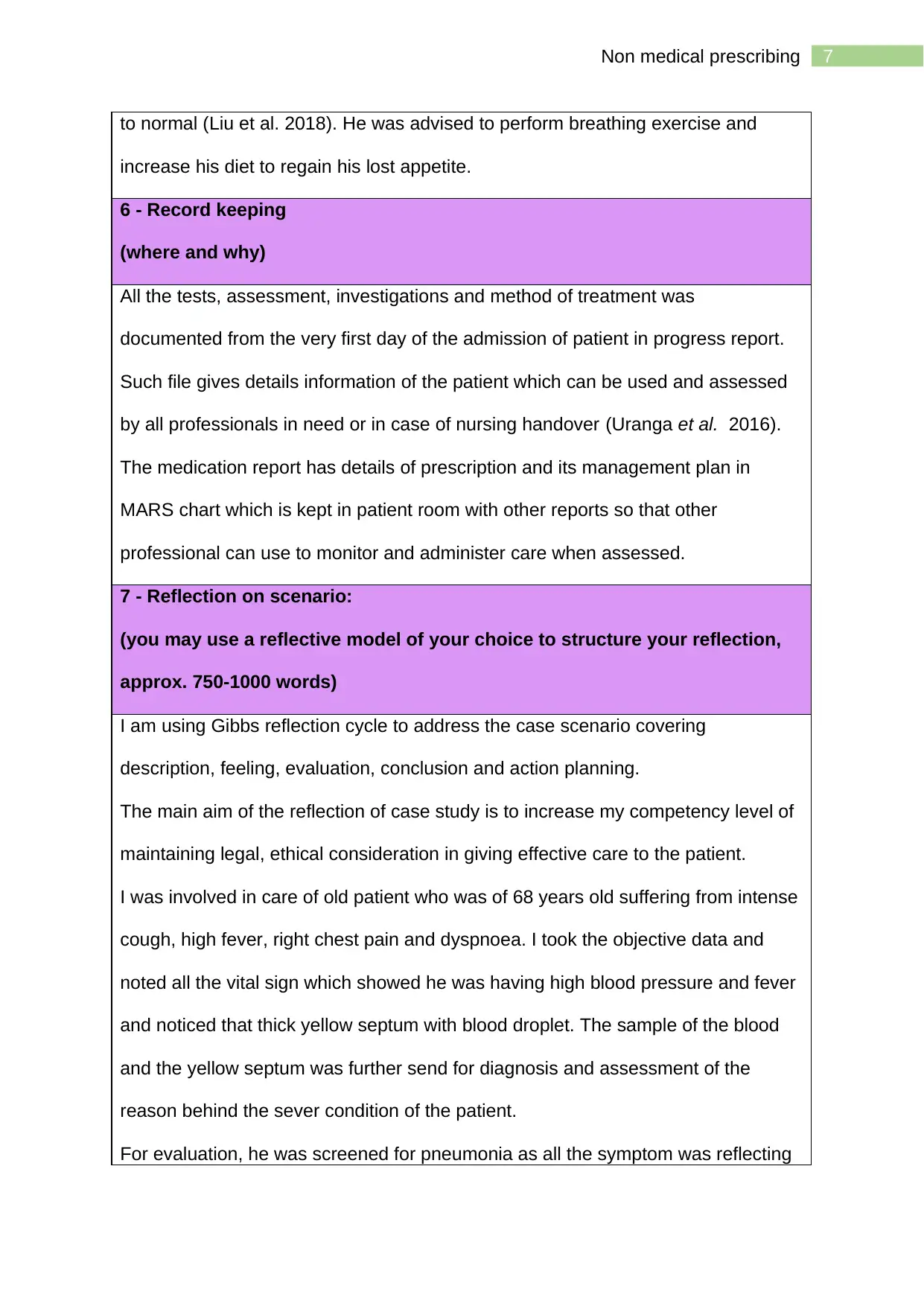
7Non medical prescribing
to normal (Liu et al. 2018). He was advised to perform breathing exercise and
increase his diet to regain his lost appetite.
6 - Record keeping
(where and why)
All the tests, assessment, investigations and method of treatment was
documented from the very first day of the admission of patient in progress report.
Such file gives details information of the patient which can be used and assessed
by all professionals in need or in case of nursing handover (Uranga et al. 2016).
The medication report has details of prescription and its management plan in
MARS chart which is kept in patient room with other reports so that other
professional can use to monitor and administer care when assessed.
7 - Reflection on scenario:
(you may use a reflective model of your choice to structure your reflection,
approx. 750-1000 words)
I am using Gibbs reflection cycle to address the case scenario covering
description, feeling, evaluation, conclusion and action planning.
The main aim of the reflection of case study is to increase my competency level of
maintaining legal, ethical consideration in giving effective care to the patient.
I was involved in care of old patient who was of 68 years old suffering from intense
cough, high fever, right chest pain and dyspnoea. I took the objective data and
noted all the vital sign which showed he was having high blood pressure and fever
and noticed that thick yellow septum with blood droplet. The sample of the blood
and the yellow septum was further send for diagnosis and assessment of the
reason behind the sever condition of the patient.
For evaluation, he was screened for pneumonia as all the symptom was reflecting
to normal (Liu et al. 2018). He was advised to perform breathing exercise and
increase his diet to regain his lost appetite.
6 - Record keeping
(where and why)
All the tests, assessment, investigations and method of treatment was
documented from the very first day of the admission of patient in progress report.
Such file gives details information of the patient which can be used and assessed
by all professionals in need or in case of nursing handover (Uranga et al. 2016).
The medication report has details of prescription and its management plan in
MARS chart which is kept in patient room with other reports so that other
professional can use to monitor and administer care when assessed.
7 - Reflection on scenario:
(you may use a reflective model of your choice to structure your reflection,
approx. 750-1000 words)
I am using Gibbs reflection cycle to address the case scenario covering
description, feeling, evaluation, conclusion and action planning.
The main aim of the reflection of case study is to increase my competency level of
maintaining legal, ethical consideration in giving effective care to the patient.
I was involved in care of old patient who was of 68 years old suffering from intense
cough, high fever, right chest pain and dyspnoea. I took the objective data and
noted all the vital sign which showed he was having high blood pressure and fever
and noticed that thick yellow septum with blood droplet. The sample of the blood
and the yellow septum was further send for diagnosis and assessment of the
reason behind the sever condition of the patient.
For evaluation, he was screened for pneumonia as all the symptom was reflecting
Paraphrase This Document
Need a fresh take? Get an instant paraphrase of this document with our AI Paraphraser
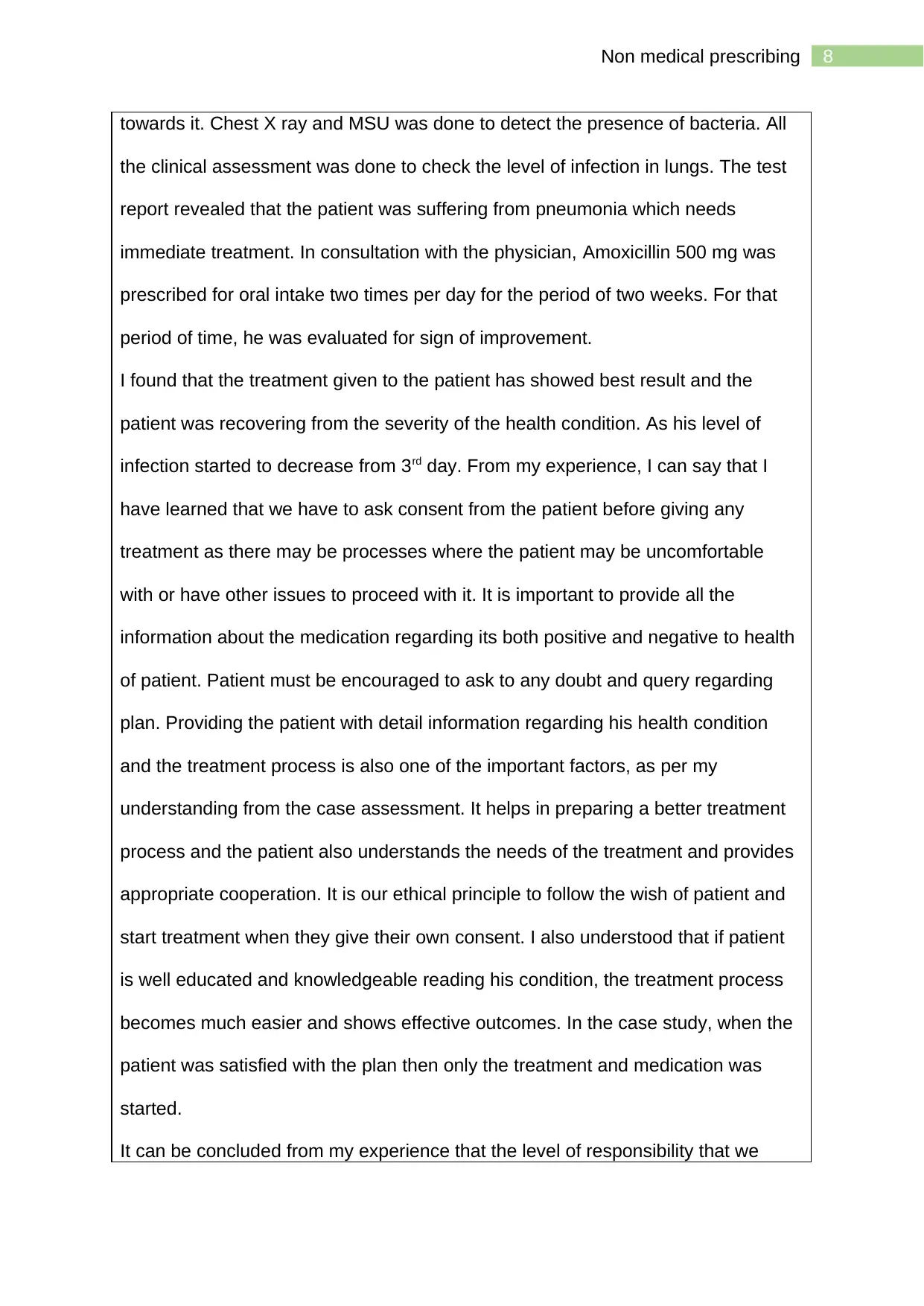
8Non medical prescribing
towards it. Chest X ray and MSU was done to detect the presence of bacteria. All
the clinical assessment was done to check the level of infection in lungs. The test
report revealed that the patient was suffering from pneumonia which needs
immediate treatment. In consultation with the physician, Amoxicillin 500 mg was
prescribed for oral intake two times per day for the period of two weeks. For that
period of time, he was evaluated for sign of improvement.
I found that the treatment given to the patient has showed best result and the
patient was recovering from the severity of the health condition. As his level of
infection started to decrease from 3rd day. From my experience, I can say that I
have learned that we have to ask consent from the patient before giving any
treatment as there may be processes where the patient may be uncomfortable
with or have other issues to proceed with it. It is important to provide all the
information about the medication regarding its both positive and negative to health
of patient. Patient must be encouraged to ask to any doubt and query regarding
plan. Providing the patient with detail information regarding his health condition
and the treatment process is also one of the important factors, as per my
understanding from the case assessment. It helps in preparing a better treatment
process and the patient also understands the needs of the treatment and provides
appropriate cooperation. It is our ethical principle to follow the wish of patient and
start treatment when they give their own consent. I also understood that if patient
is well educated and knowledgeable reading his condition, the treatment process
becomes much easier and shows effective outcomes. In the case study, when the
patient was satisfied with the plan then only the treatment and medication was
started.
It can be concluded from my experience that the level of responsibility that we
towards it. Chest X ray and MSU was done to detect the presence of bacteria. All
the clinical assessment was done to check the level of infection in lungs. The test
report revealed that the patient was suffering from pneumonia which needs
immediate treatment. In consultation with the physician, Amoxicillin 500 mg was
prescribed for oral intake two times per day for the period of two weeks. For that
period of time, he was evaluated for sign of improvement.
I found that the treatment given to the patient has showed best result and the
patient was recovering from the severity of the health condition. As his level of
infection started to decrease from 3rd day. From my experience, I can say that I
have learned that we have to ask consent from the patient before giving any
treatment as there may be processes where the patient may be uncomfortable
with or have other issues to proceed with it. It is important to provide all the
information about the medication regarding its both positive and negative to health
of patient. Patient must be encouraged to ask to any doubt and query regarding
plan. Providing the patient with detail information regarding his health condition
and the treatment process is also one of the important factors, as per my
understanding from the case assessment. It helps in preparing a better treatment
process and the patient also understands the needs of the treatment and provides
appropriate cooperation. It is our ethical principle to follow the wish of patient and
start treatment when they give their own consent. I also understood that if patient
is well educated and knowledgeable reading his condition, the treatment process
becomes much easier and shows effective outcomes. In the case study, when the
patient was satisfied with the plan then only the treatment and medication was
started.
It can be concluded from my experience that the level of responsibility that we
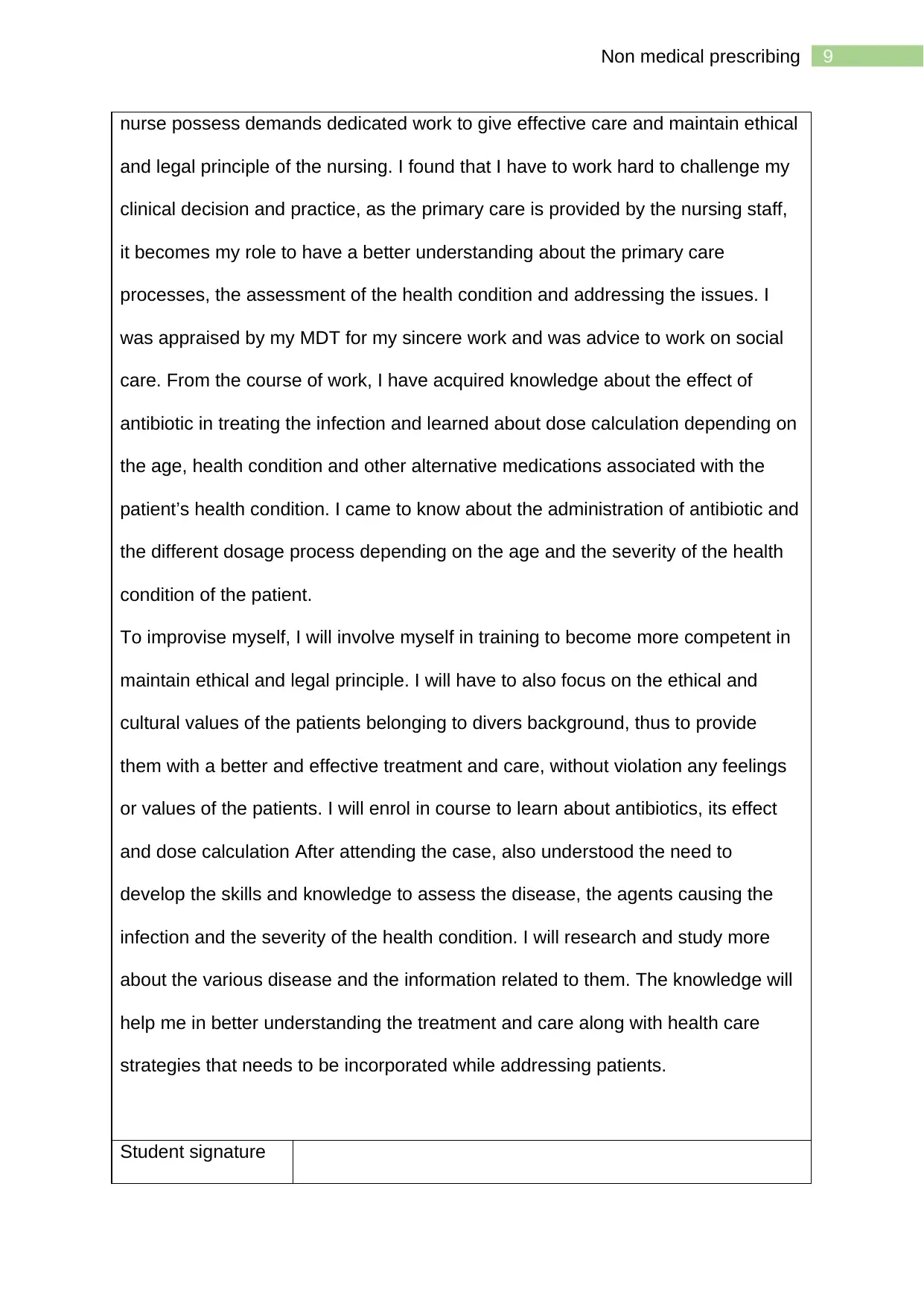
9Non medical prescribing
nurse possess demands dedicated work to give effective care and maintain ethical
and legal principle of the nursing. I found that I have to work hard to challenge my
clinical decision and practice, as the primary care is provided by the nursing staff,
it becomes my role to have a better understanding about the primary care
processes, the assessment of the health condition and addressing the issues. I
was appraised by my MDT for my sincere work and was advice to work on social
care. From the course of work, I have acquired knowledge about the effect of
antibiotic in treating the infection and learned about dose calculation depending on
the age, health condition and other alternative medications associated with the
patient’s health condition. I came to know about the administration of antibiotic and
the different dosage process depending on the age and the severity of the health
condition of the patient.
To improvise myself, I will involve myself in training to become more competent in
maintain ethical and legal principle. I will have to also focus on the ethical and
cultural values of the patients belonging to divers background, thus to provide
them with a better and effective treatment and care, without violation any feelings
or values of the patients. I will enrol in course to learn about antibiotics, its effect
and dose calculation After attending the case, also understood the need to
develop the skills and knowledge to assess the disease, the agents causing the
infection and the severity of the health condition. I will research and study more
about the various disease and the information related to them. The knowledge will
help me in better understanding the treatment and care along with health care
strategies that needs to be incorporated while addressing patients.
Student signature
nurse possess demands dedicated work to give effective care and maintain ethical
and legal principle of the nursing. I found that I have to work hard to challenge my
clinical decision and practice, as the primary care is provided by the nursing staff,
it becomes my role to have a better understanding about the primary care
processes, the assessment of the health condition and addressing the issues. I
was appraised by my MDT for my sincere work and was advice to work on social
care. From the course of work, I have acquired knowledge about the effect of
antibiotic in treating the infection and learned about dose calculation depending on
the age, health condition and other alternative medications associated with the
patient’s health condition. I came to know about the administration of antibiotic and
the different dosage process depending on the age and the severity of the health
condition of the patient.
To improvise myself, I will involve myself in training to become more competent in
maintain ethical and legal principle. I will have to also focus on the ethical and
cultural values of the patients belonging to divers background, thus to provide
them with a better and effective treatment and care, without violation any feelings
or values of the patients. I will enrol in course to learn about antibiotics, its effect
and dose calculation After attending the case, also understood the need to
develop the skills and knowledge to assess the disease, the agents causing the
infection and the severity of the health condition. I will research and study more
about the various disease and the information related to them. The knowledge will
help me in better understanding the treatment and care along with health care
strategies that needs to be incorporated while addressing patients.
Student signature
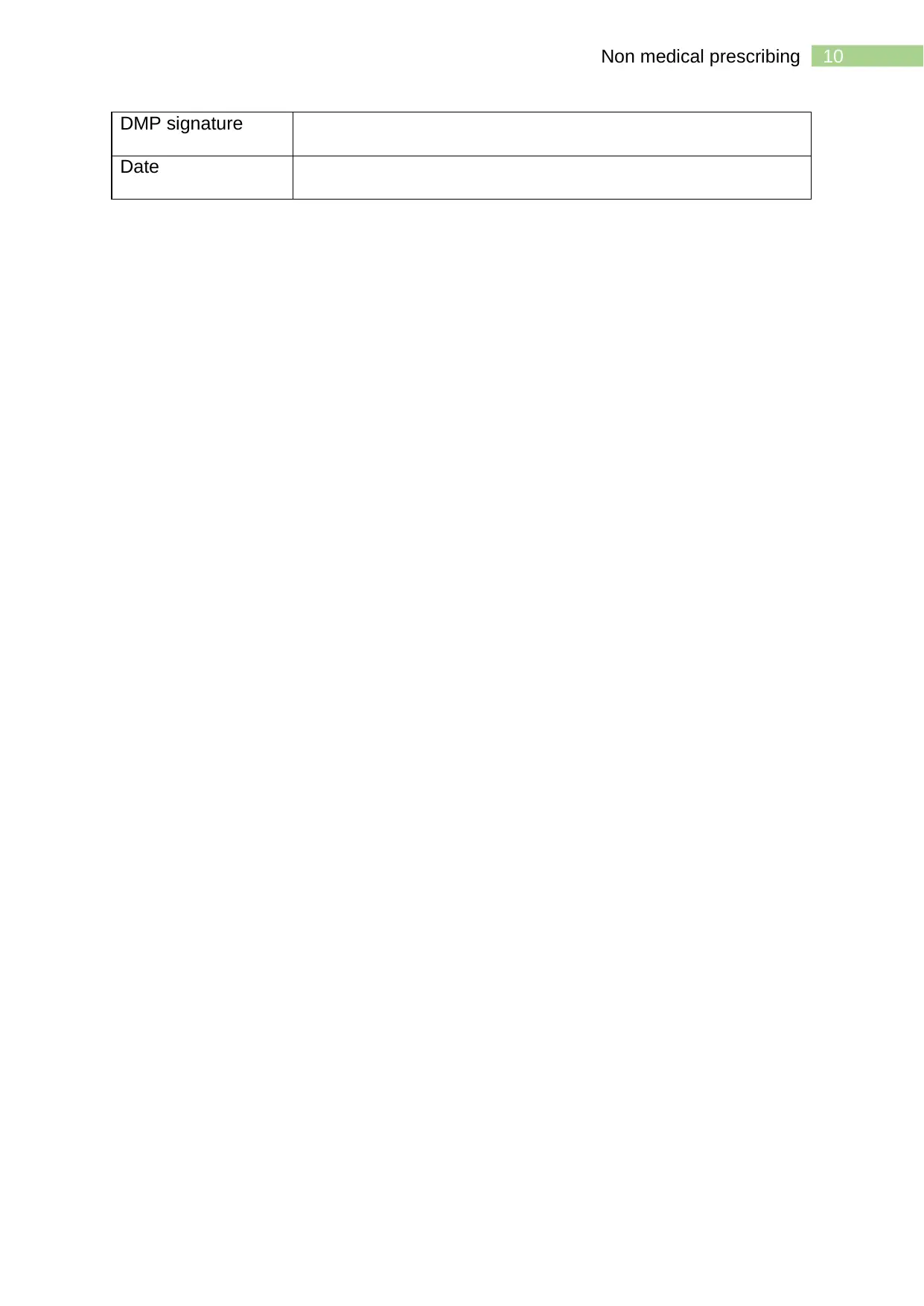
10Non medical prescribing
DMP signature
Date
DMP signature
Date
Secure Best Marks with AI Grader
Need help grading? Try our AI Grader for instant feedback on your assignments.
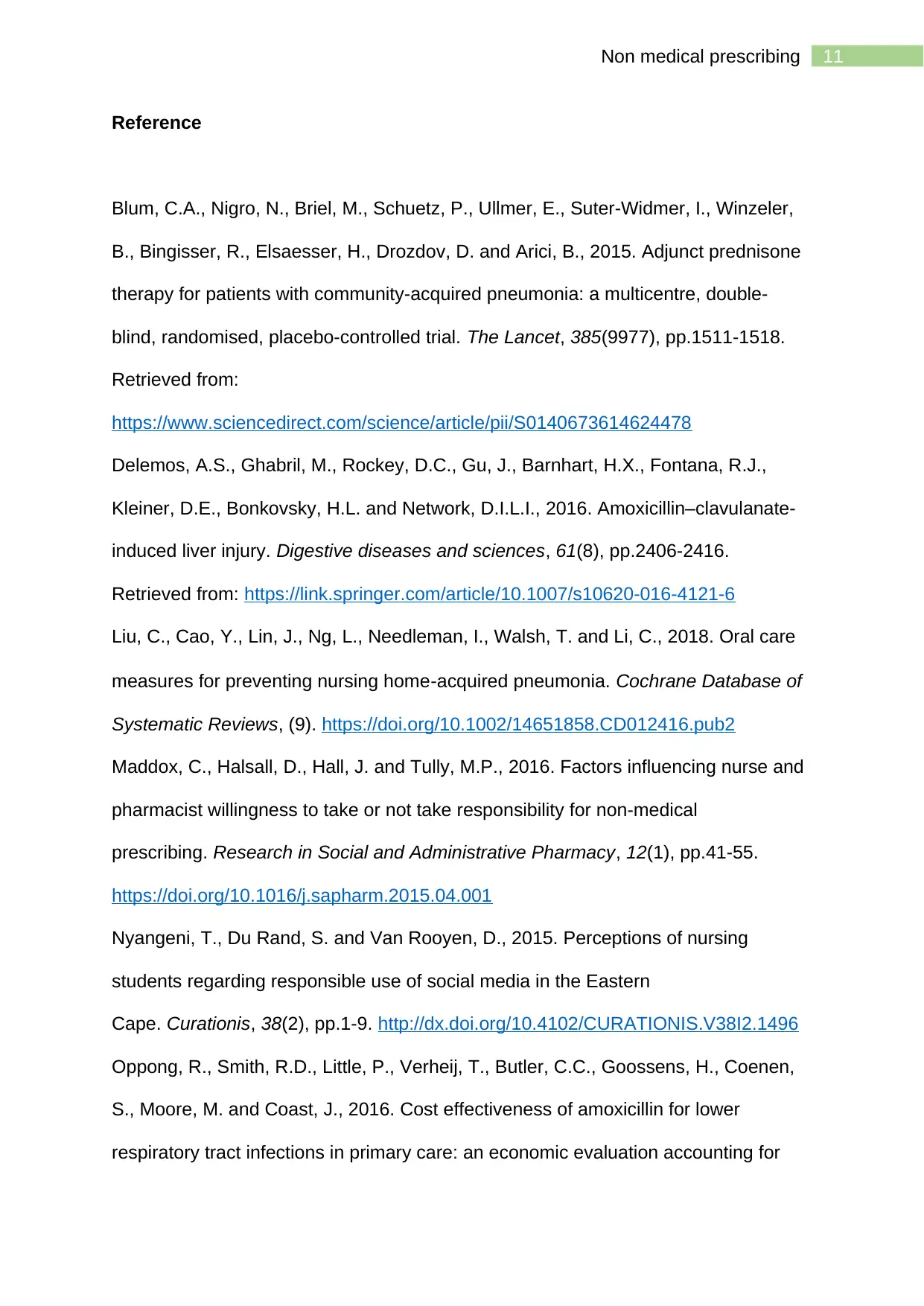
11Non medical prescribing
Reference
Blum, C.A., Nigro, N., Briel, M., Schuetz, P., Ullmer, E., Suter-Widmer, I., Winzeler,
B., Bingisser, R., Elsaesser, H., Drozdov, D. and Arici, B., 2015. Adjunct prednisone
therapy for patients with community-acquired pneumonia: a multicentre, double-
blind, randomised, placebo-controlled trial. The Lancet, 385(9977), pp.1511-1518.
Retrieved from:
https://www.sciencedirect.com/science/article/pii/S0140673614624478
Delemos, A.S., Ghabril, M., Rockey, D.C., Gu, J., Barnhart, H.X., Fontana, R.J.,
Kleiner, D.E., Bonkovsky, H.L. and Network, D.I.L.I., 2016. Amoxicillin–clavulanate-
induced liver injury. Digestive diseases and sciences, 61(8), pp.2406-2416.
Retrieved from: https://link.springer.com/article/10.1007/s10620-016-4121-6
Liu, C., Cao, Y., Lin, J., Ng, L., Needleman, I., Walsh, T. and Li, C., 2018. Oral care
measures for preventing nursing home‐acquired pneumonia. Cochrane Database of
Systematic Reviews, (9). https://doi.org/10.1002/14651858.CD012416.pub2
Maddox, C., Halsall, D., Hall, J. and Tully, M.P., 2016. Factors influencing nurse and
pharmacist willingness to take or not take responsibility for non-medical
prescribing. Research in Social and Administrative Pharmacy, 12(1), pp.41-55.
https://doi.org/10.1016/j.sapharm.2015.04.001
Nyangeni, T., Du Rand, S. and Van Rooyen, D., 2015. Perceptions of nursing
students regarding responsible use of social media in the Eastern
Cape. Curationis, 38(2), pp.1-9. http://dx.doi.org/10.4102/CURATIONIS.V38I2.1496
Oppong, R., Smith, R.D., Little, P., Verheij, T., Butler, C.C., Goossens, H., Coenen,
S., Moore, M. and Coast, J., 2016. Cost effectiveness of amoxicillin for lower
respiratory tract infections in primary care: an economic evaluation accounting for
Reference
Blum, C.A., Nigro, N., Briel, M., Schuetz, P., Ullmer, E., Suter-Widmer, I., Winzeler,
B., Bingisser, R., Elsaesser, H., Drozdov, D. and Arici, B., 2015. Adjunct prednisone
therapy for patients with community-acquired pneumonia: a multicentre, double-
blind, randomised, placebo-controlled trial. The Lancet, 385(9977), pp.1511-1518.
Retrieved from:
https://www.sciencedirect.com/science/article/pii/S0140673614624478
Delemos, A.S., Ghabril, M., Rockey, D.C., Gu, J., Barnhart, H.X., Fontana, R.J.,
Kleiner, D.E., Bonkovsky, H.L. and Network, D.I.L.I., 2016. Amoxicillin–clavulanate-
induced liver injury. Digestive diseases and sciences, 61(8), pp.2406-2416.
Retrieved from: https://link.springer.com/article/10.1007/s10620-016-4121-6
Liu, C., Cao, Y., Lin, J., Ng, L., Needleman, I., Walsh, T. and Li, C., 2018. Oral care
measures for preventing nursing home‐acquired pneumonia. Cochrane Database of
Systematic Reviews, (9). https://doi.org/10.1002/14651858.CD012416.pub2
Maddox, C., Halsall, D., Hall, J. and Tully, M.P., 2016. Factors influencing nurse and
pharmacist willingness to take or not take responsibility for non-medical
prescribing. Research in Social and Administrative Pharmacy, 12(1), pp.41-55.
https://doi.org/10.1016/j.sapharm.2015.04.001
Nyangeni, T., Du Rand, S. and Van Rooyen, D., 2015. Perceptions of nursing
students regarding responsible use of social media in the Eastern
Cape. Curationis, 38(2), pp.1-9. http://dx.doi.org/10.4102/CURATIONIS.V38I2.1496
Oppong, R., Smith, R.D., Little, P., Verheij, T., Butler, C.C., Goossens, H., Coenen,
S., Moore, M. and Coast, J., 2016. Cost effectiveness of amoxicillin for lower
respiratory tract infections in primary care: an economic evaluation accounting for
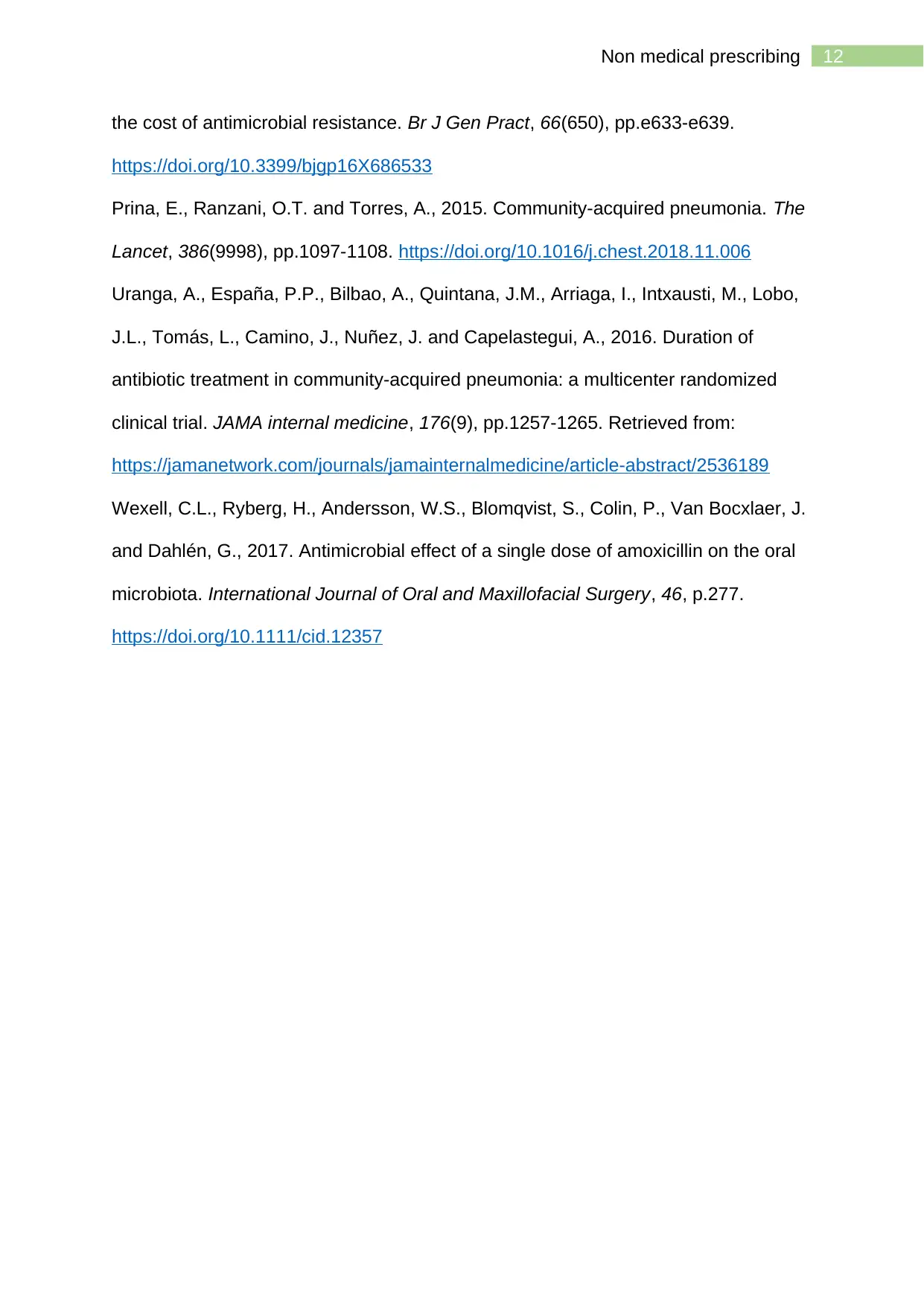
12Non medical prescribing
the cost of antimicrobial resistance. Br J Gen Pract, 66(650), pp.e633-e639.
https://doi.org/10.3399/bjgp16X686533
Prina, E., Ranzani, O.T. and Torres, A., 2015. Community-acquired pneumonia. The
Lancet, 386(9998), pp.1097-1108. https://doi.org/10.1016/j.chest.2018.11.006
Uranga, A., España, P.P., Bilbao, A., Quintana, J.M., Arriaga, I., Intxausti, M., Lobo,
J.L., Tomás, L., Camino, J., Nuñez, J. and Capelastegui, A., 2016. Duration of
antibiotic treatment in community-acquired pneumonia: a multicenter randomized
clinical trial. JAMA internal medicine, 176(9), pp.1257-1265. Retrieved from:
https://jamanetwork.com/journals/jamainternalmedicine/article-abstract/2536189
Wexell, C.L., Ryberg, H., Andersson, W.S., Blomqvist, S., Colin, P., Van Bocxlaer, J.
and Dahlén, G., 2017. Antimicrobial effect of a single dose of amoxicillin on the oral
microbiota. International Journal of Oral and Maxillofacial Surgery, 46, p.277.
https://doi.org/10.1111/cid.12357
the cost of antimicrobial resistance. Br J Gen Pract, 66(650), pp.e633-e639.
https://doi.org/10.3399/bjgp16X686533
Prina, E., Ranzani, O.T. and Torres, A., 2015. Community-acquired pneumonia. The
Lancet, 386(9998), pp.1097-1108. https://doi.org/10.1016/j.chest.2018.11.006
Uranga, A., España, P.P., Bilbao, A., Quintana, J.M., Arriaga, I., Intxausti, M., Lobo,
J.L., Tomás, L., Camino, J., Nuñez, J. and Capelastegui, A., 2016. Duration of
antibiotic treatment in community-acquired pneumonia: a multicenter randomized
clinical trial. JAMA internal medicine, 176(9), pp.1257-1265. Retrieved from:
https://jamanetwork.com/journals/jamainternalmedicine/article-abstract/2536189
Wexell, C.L., Ryberg, H., Andersson, W.S., Blomqvist, S., Colin, P., Van Bocxlaer, J.
and Dahlén, G., 2017. Antimicrobial effect of a single dose of amoxicillin on the oral
microbiota. International Journal of Oral and Maxillofacial Surgery, 46, p.277.
https://doi.org/10.1111/cid.12357
1 out of 12
Related Documents
Your All-in-One AI-Powered Toolkit for Academic Success.
+13062052269
info@desklib.com
Available 24*7 on WhatsApp / Email
![[object Object]](/_next/static/media/star-bottom.7253800d.svg)
Unlock your academic potential
© 2024 | Zucol Services PVT LTD | All rights reserved.





